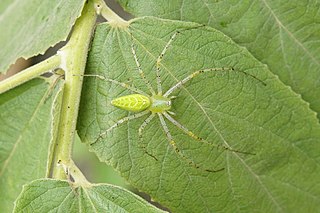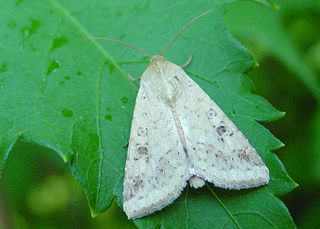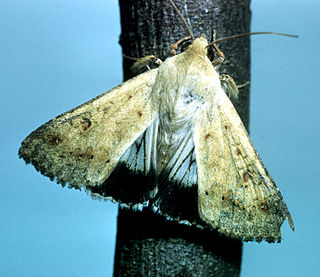
Helicoverpa zea, commonly known as the corn earworm, is a species in the family Noctuidae. The larva of the moth Helicoverpa zea is a major agricultural pest. Since it is polyphagous during the larval stage, the species has been given many different common names, including the cotton bollworm and the tomato fruitworm. It also consumes a wide variety of other crops.

Trichogramma is a genus of minute polyphagous wasps that are endoparasitoids of insect eggs. Trichogramma is one of around 80 genera from the family Trichogrammatidae, with over 200 species worldwide.

Bollworm is the common term for a moth larva that attacks the fruiting bodies of certain crops, especially cotton. The most common moths known as bollworms are:

The pink bollworm is an insect known for being a pest in cotton farming. The adult is a small, thin, gray moth with fringed wings. The larva is a dull white caterpillar with eight pairs of legs with conspicuous pink banding along its dorsum. The larva reaches one half inch in length.

Peucetia viridans, the green lynx spider, is a bright-green lynx spider usually found on green plants. It is the largest North American species in the family Oxyopidae. This spider is common in the southern U.S., Mexico, Central America, and in many West Indies islands, especially Jamaica.
Bt cotton is a genetically modified pest resistant plant cotton variety, which produce an insecticide to combat bollworm.

Helicoverpa armigera is a species of Lepidoptera in the family Noctuidae. It is known as the cotton bollworm, corn earworm, Old World (African) bollworm, or scarce bordered straw. The larvae feed on a wide range of plants, including many important cultivated crops. It is a major pest in cotton and one of the most polyphagous and cosmopolitan pest species. It should not be confused with the similarly named larva of the related species Helicoverpa zea.
Maurice James Lukefahr, a pioneer researcher in the fields of host plant resistance and environmental control of cotton insect pests, died in Elsa, Texas in 2002.
The Bureau of Entomology was a unit within the Federal government of the United States from 1894 to 1934. It developed from a section of the Department of Agriculture which had been working on entomological researches and allied issues relating to insects. In 1934 it was merged with the Bureau of Plant Quarantine to form the Bureau of Entomology and Plant Quarantine. A later merger with the Bureau of Animal Industry created the Agricultural Research Service in 1953.

Helicoverpa is a genus of moths in the family Noctuidae first described by David F. Hardwick in 1965. Some species are among the worst Lepidopteran agricultural pests in the world, and three species migrate long distances both with and without human transportation, mixing resistance alleles along the way.

Pectinophora is a genus of moths in the family Gelechiidae. Perhaps the best known species is the pink bollworm, Pectinophora gossypiella (Saunders). P. gossypiella is one of the world's most destructive insect pests that causes terrible damage to cotton bolls. The larvae (caterpillars) bore into the bolls, causing them to fall or the blossoms to fail to open. The larvae tunnel through the immature lint and into the seeds eating them. As a result the lint may be unpickable or so stunted as to greatly lower the yield and grade. The yield of oil from the seeds is greatly reduced. Double seeds are found when the cotton is gained, two partly eaten seeds being fastened together.

Helicoverpa punctigera, the native budworm, Australian bollworm or Chloridea marmada, is a species of moth in the family Noctuidae. This species is native to Australia. H. punctigera are capable of long-distance migration from their inland Australian habitat towards coastal regions and are an occasional migrant to New Zealand.

Heliothis punctifera or the lesser budworm, is an Australian moth of the family Noctuidae; one of the most migratory families of insects. It is considered a pest species to agricultural crops, however, due to its inland habitat, is found to be less damaging to agricultural areas than other species of the genus.

Coccinella transversalis, commonly known as the transverse ladybird or transverse lady beetle is a species of ladybird beetle found from India across southern and southeastern Asia to Malesia and Australia. It is not to be confused with Coccinella transversoguttata, a widespread species in Europe and North America also known as the transverse ladybird. The alternative vernacular of small transverse ladybird may be used for C. transversalis in instances where these two species are discussed together.

Chloridea virescens, commonly known as the tobacco budworm, is a moth of the family Noctuidae found throughout the eastern and southwestern United States along with parts of Central America and South America.

Helicoverpa gelotopoeon, the South American bollworm moth, is a moth of the family Noctuidae. It is found in southern South America, including Chile and Argentina.

Helicoverpa fletcheri is a species of moth of the family Noctuidae that is found in Africa, including Sudan.

Diparopsis castanea is the type species of the genus Diparopsis: moths in the family Noctuidae; no subspecies are listed in the Catalogue of Life. This is known as the red bollworm, which is a significant pest of cotton crops in Eastern and Central-Southern Africa.
Rhynocoris longifrons is a species of assassin bug in the family Reduviidae. It is a predator of other insects and is found in Asia. Crops on which it is found feeding on pests include pigeon pea, cardamom and peanuts. The insects are potentially useful in biological control because they are more resistant to pesticides than are the pests they consume.

Acanthaspis quinquespinosa is a species of assassin bug found in India, Sri Lanka, Myanmar, Nepal and Tibet. It is a predator, and both nymphs and adults feed on termites, beetles, caterpillars and other insect prey.














